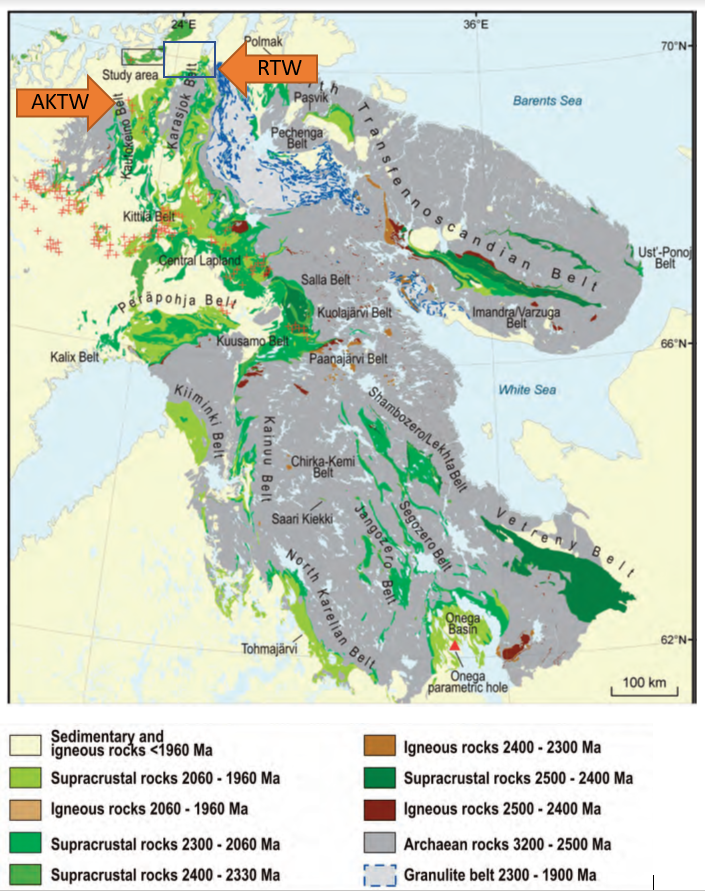Yulia Mun, Sabina Strmic Palinkas, Harald Hansen, Sondre S. Simonsen, Johan Hilmo, Fredrik Sahlström, Hugh O’Brian, Steffen G. Bergh, Carly Faber, Matthias Forwick
Two Arctic sites, Repparfjord Tectonic Window (RTW) and Alta-Kvænangen Tectonic Window (AKTW), in Northern Norway were chosen to demonstrate applicability of the MinExTarget fingerprinting tools (Figure 1). Both tectonic windows are basement culminations of the Paleoproterozoic basement surrounded by Norwegian Caledonides. Copper ore occurrences were known and mined in both tectonic windows in the period from 1820-s to 1970-s. Nowadays, mining of two sediment-hosted copper deposits, Nussir and Ulveryggen is planned in the RTW. Figure 2 demonstrates an example of mineralized hosting quartz-carbonate vein crosscutting hosting shale at the AKTW.
For the purposes of the MinExTarget project, sulfide and oxide mineral phases found in the primary mineralization as well as stream and marine sediments at the AKTW and RTW were analysed using LA-ICP-MS spot analysis (Figures 3, 4). The main ore minerals are sphalerite, bornite, chalcopyrite, and chalcocite which show distinctive trace elements distribution trends. At the AKTW it was noticed that pyrite is the first formed mineral in the paragenetic sequence followed by chalcopyrite, sphalerite, bornite, and digenite. At the RTW pyrite is present in insignificant amounts or absent altogether. Instead the first mineral in the ore mineral paragenetic sequence is chalcopyrite followed by bornite and chalcocite. Pyrite from the AKTW is enriched in Co and Ni and depleted in Se and Ag, at the same time Cu-bearing sulfide phases demonstrate significant depletion in Co and Ni and gradual enrichment in Se and Ag. The same trend is observed in Cu-sulfides from the RTW, with a higher enrichment in Se and Ag in chalcocite comparing to chalcopyrite.
Trace elements distribution was also investigated in chalcopyrite from stream sediments at the AKTW and marine sediments from the Repparfjord. The results are shown on Figure 4. As it is seen Se and Ag are enriched. Therefore, trace element distribution in exploration for sediment-hosted copper deposits in Northern Norway demonstrated that Se and Ag could be used as finger-printing elements.

Figure 1. Northeastern-most part (Archean domain) of the Fennoscandian Shield with different types and ages of Palaeoproterozoic and Archean rocks. Study areas, Alta-Kvænangen Tectonic Window (AKTW) and Repparfjord Tectonic Window (RTW) are marked. The figure is modified after Melezhik et al. (2013) and Simonsen (2021), based originally on Koistinen et al. (2001).

Figure 2. A) Photograph of the outcrop of Storviknes formation (AKTW) where Cu mineralization (chalcopyrite and bornite) is found in quartz-carbonate veins crosscutting shale B) handsample of quartz-carbonate vein with copper-bearing minerals.


Figure 3. Trace elements distribution within chalcopyrite from primary mineralization at the A) Alta-Kvænangen Tectonic Window, and B) Repparfjord Tectonic Window (Nussir).

Figure 4. Box plots demonstrating distribution of Ag and Se within chalcopyrite (Ccp), pyrite (Py) and pyrrhotite (Po) from stream sediments at the AKTW and chalcopyrite from the RTW.



